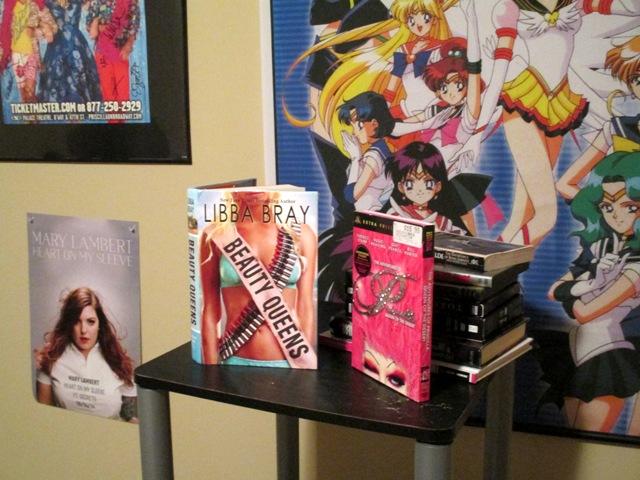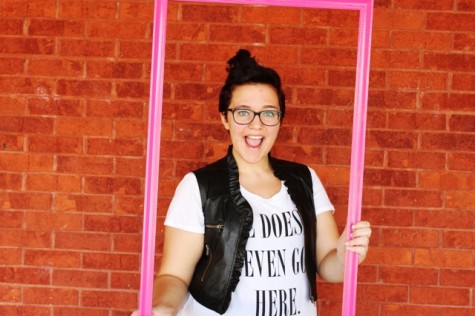LGBTQ+ Books and TV Shows for Young Adults
(Photo used with permission by Rayne Crivelli.)
Rayne Crivelli’s room is a shrine of LGBTQ+ media, featuring movies, books, and music by gay artists from all walks of life.
December 9, 2014
LGBTQ+ students often seek out media they can relate to through movies, television, music and books. It is human nature to look for a self-representation in the media they consume. Books and TV shows are popular for the long term connections young adults form through ongoing series and fan culture.
Books
Beauty Queens by Libba Bray – At first glance, many find themselves put off by Beauty Queens. The story of teenage beauty pageant contestants trying to survive on an island after a plane crash may sound like a vapid excursion into every feminist’s nightmare, but it instead serves as a delightful inversion of the young adult genre. Through their isolated experience, they begin to notice the negative effects society has had on their self image and one starts to wonder where they are safer: on an island with little food and dangerous animals just beyond the palm trees or in a society that oppresses their opinions and teaches them to be subservient to men. The book is a parody of modern culture that features a twist of epic proportions and some sexy pirates.
The Bermudez Triangle by Maureen Johnson – Maureen Johnson follows the story of three young girls in the summer before they leave for college. After coming back from vacation, Nina Bermudez finds her two best friends are gay, and dating each other. The Bermudez Triangle paints a beautiful picture of the life of a questioning teenage girl and dealing with the boundaries of friendship.
Boy Meets Boy by David Levithan – Boy Meets Boy seems to take place in a gay utopia of sorts. The promised land all LGBTQ+ teenagers dream about, where the drag queens of the school get their own homecoming float and nobody is bullied because of their sexual orientation. While not accurate in any sense to the real world, it is a good place to escape every once in a while.
Will Grayson, Will Grayson by John Green and David Levithan – Cowritten by David Levithan and John Green, Will Grayson, Will Grayson features two boys (both named Will Grayson) and explores how their lives one day unintentionally overlap and how the event changes and connects them for life. It also features Tiny Cooper, one of the largest gay characters in Young Adult fiction (literally).
The Perks of Being a Wallflower – Written by Stephen Chbosky, The Perks of Being a Wallflower is a novel that has touched millions of students. It features a wide array of characters, all landing within the different spectrum of sexuality, and the main character’s observations of life around him are astute and honest.
TV Shows
Rather than listing each show by name, characters from the shows will be analyzed to provide a more streamlined image of the series (as some are not very good, but may be worth checking out for the characters).
Kurt Hummel, Glee – Glee is a show that haunts the dreams of those who dare to watch past season one or form an emotional connection to any of the characters. The continuity is inconsistent, and the showrunners tend to run sexist, racist and even homophobic storylines more often than viewers would like. It’s arguably the worst piece of media on this list, yet there’s something about it that sticks with LGBTQ+ youth. Perhaps it is the characters that make it bearable. Kurt Hummel is one of the most recognizable television characters of the decade, and he danced into viewers hearts almost immediately in season one. There are many other LGBTQ+ characters on Glee, but most are inaccurate representations of the community or unlikeable characters. For instance, Blaine is abusive towards Kurt throughout their relationship (using emotional manipulation tactics that are never addressed by the series) and Brittany is a bisexual woman who the writers refuse to let out of the closet (only ever referring to her as “bi-curious”, even though she has maintained a committed relationship with a woman for over three seasons). It is recommended to watch through the fourth episode of season two, but not past then, as the lack of continuity and absurd drama every week will provide watchers with a strong sense of disillusionment and disappointment.
Paige and Emily, Pretty Little Liars – Pretty Little Liars is a teenage soap opera airing on ABC Family. While it tends to air on the side of ridiculous more often than not, it still provides great entertainment value and features an exceedingly numerous amount of LGBTQ+ characters for a teenage drama. With such a wide range of gay representation, almost any LGBTQ+ teen would be able to find a character they can closely identify with.
Danny, Teen Wolf – Of all of the characters in Teen Wolf (a modern TV adaptation of the 1985 movie), Danny is by far the most loved. He is an openly gay lacrosse player and best friends with the most popular people in school, showing just the kind of world Jeff Davis (the openly gay showrunner) wanted to create. Davis wanted the drama to be about the werewolves, not about teen sexuality, so he essentially made a world free of homophobia in the hopes that it would one day reflect reality. Davis is well known for his work in the LGBTQ+ community and his work implies that Danny will not be the last LGBTQ+ character Teen Wolf fans see anytime soon.
Willow and Tara, Buffy the Vampire Slayer – Willow and Tara were seen as the original lesbian “it” couple. They began their relationship in season four of Buffy the Vampire Slayer and it carried on for two seasons. Even after the relationship ended and Willow found a new partner, many were unhappy about the relationship’s end and refuse to acknowledge Willow’s second girlfriend, Kennedy. Regardless of their rocky end, Willow and Tara are still seen by many as a shining example of a LGBTQ+ representation and look up to the two as role models. It also helps that they are from one of the most prominent icons of third wave feminism – the television show Buffy the Vampire Slayer.
Justin Suarez, Ugly Betty – Justin Suarez was a character Ugly Betty fans got to see grow up, from his pre-teen years in seasons one and two, to his movement into high school and his budding relationship with his best friend. He sought a mentor in Marc St. James, a flamboyant assistant at Mode Fashion Magazine and the idol all LGBTQ+ youth wished to have growing up, and his coming out scene was one of the most touching moments of the series.




